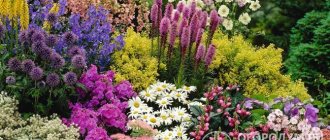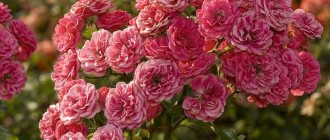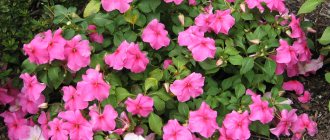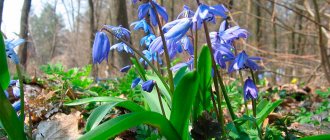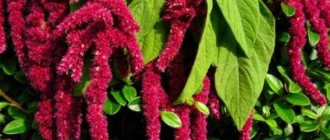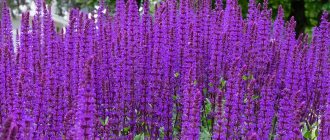The color red symbolizes energy, beauty and love. Therefore, since ancient times, flowers in fiery shades have always been woven into wreaths and planted in flower beds. Times have changed, but this color is still popular in garden design. It is actively used to complement flower beds, make bright accents on the site, and highlight landscape areas. We suggest studying the best red perennials, which stand out for their originality, can harmoniously complement the territory, and add bright accents to the area.
Low growing perennials with red flowers
Low-growing garden crops look great in borders, complementing paths or alleys. These flowers will be a creative option to complement the rest and relaxation area. Let's consider the most interesting options for low-growing crops that will harmoniously fit into any flower bed.
Spring Primrose
These flowers greet us with the first warmth. They truly symbolize spring and provide lush blooms. The bushes are distinguished by wrinkled, wavy leaves covered with hairs. Often primrose is also called “keys”. Traditionally, primrose blooms with yellow buds, but there are many varieties with red petals. The most popular is the Chinese primrose, which has red-brown peduncles. The crops prefer light types of soil and can be propagated by different methods - seed, cuttings, and dividing the bush.
For comfortable growth of bushes, you need to make a distance of 15 centimeters between them. The height of such beauties reaches up to 10-30 cm. Primrose will bloom within a month, starting from April and ending in May.
You might be interested
Decorative liana Ipomoea: cultivation and use in garden design
Red perennials: the best plants to grow in the garden
List of the best blue flowers and plants with blue foliage
Blood Red Cinquefoil
A beautiful perennial with red flowers is blood red cinquefoil. Its height is up to 0.6 meters. The culture is distinguished by straight, branched stems. The leaves are usually trifoliate in shape and have a dull green color on top. This culture is valued due to its flowers of incredible beauty. Their color is usually a brilliant red hue, up to 5 cm in diameter, they form paniculate or corymbose buds. Flowering is long - up to 50 days.
There are a large number of hybrids - among them "Gibson Scarlet", which is distinguished by scarlet-red petals with a slight shiny tint. You can see abundant flowers during June-July.
Border Chrysanthemums
Excellent red perennial flowers are border varieties of chrysanthemums. In gardening, such varieties are also called “Korean” or “Chinese”. These crops are distinguished by the fact that they are resistant to cold conditions and will delight you with long-lasting flowering. Border varieties are considered crumb flowers, which do not reach more than 0.3 meters in height, and independently form the ideal outline of a bush in the form of a ball. “Talisman” is considered the best varieties. These flowers have a bright color in raspberry-beet tones. The “Evening Lights” variety also looks very attractive. With their dazzling flashes of scarlet petals, they will easily complement any area and create incredible holiday euphoria.
Alternanthera
These spreading bushes (about 20 cm high) with oblong-spatulate variegated leaves will also fit perfectly into any flower garden. Alternanthera has many garden forms that differ in leaf color, but most varieties are dominated by green, red and pink shades.
Alternanthera red
Alternanthera sessile
Alternanthera looks best when grown in a sunny area with poor but well-drained soil. Like coleus, plants are transplanted into containers and kept indoors for the winter. In June, the bushes are planted again in open ground and watered moderately.
Tall perennials with red flowers
If we have figured out the formation of borders, now we should think about how large areas on the site and mixborders will be decorated. The ideal solution in this case would be to use tall representatives with fiery petals. Let's look at the brightest red perennials.
Heleniums or red chamomile perennials
Helenums are tall red perennials that belong to the Asteraceae family. The homeland of such cultures is considered to be the territory of Eastern America. The height of specimens can reach up to 1.6 meters. The stem can be smooth, branched or straight. The leaves are usually lanceolate in shape and do not develop chaotically, but in order of priority.
Helenium usually forms a hemisphere, enveloped in yellow pollen. The central part is framed by circular petals. Visually, they resemble chamomile, hence the second name for heleniums.
Stem height up to 0.9 meters. Flowering can be observed within 5-6 weeks. These perennials will delight you with their fiery flowers from late summer to early autumn. When flowering ends, cylindrical seeds will form on the plant. In order for the bushes to develop beautifully and fully, they need to be watered abundantly and the soil well fertilized.
Exquisite Adonis or Adonis
Adonis is a red perennial that can also be grown as an annual. The plant is actively used in landscape design and has a wide range of healing properties. Therefore, the culture is listed in the International Red Book.
Adonis forms exquisite bushes that are distinguished by their lush appearance. The petals are fiery red in color, visually similar to chamomile. This flower is up to 3 cm in diameter. The total number of species is up to 32. Flowering lasts throughout the whole summer. To grow adonis, it is recommended to choose illuminated areas; the soil can be any kind. If the weather is excessively hot, additional watering of the bushes will be required.
Refined red garden perennial - Poppy
Poppy is a plant that has been familiar to many since childhood. But now, in addition to the usual variety, there are also decorative ones, with terry leaves. The height of the crops is up to 1.2 meters. To make poppies bloom continuously, you need to sow them every 10 days.
These red perennials have narrow leaves with small teeth along the edges. The flowers are created from 4 petals with two sepals. A tap root that goes deep into the ground. For growing poppies, it is better to choose areas with good lighting. Caring for the crop is not burdensome, the main thing is that it does not grow in areas with stagnant moisture or close groundwater.
Original Astilbe
Another red perennial is astilbe. These are herbaceous crops that belong to the Saxifraga family. There are more than 40 varieties of the plant, as well as about 400 cultivars. Astilbe height is up to 2 meters. The flowers form very sophisticated and attractive panicle-shaped inflorescences. Their length is up to 0.6 meters. The color varies, but the red buds deserve special attention. The Japanese astilib Montgomery is distinguished by such beauty. The height of the bushes is up to 0.7 meters, the leaves are usually reddish-brown in color. This beauty begins to bloom in the second half of July, this period lasts for 2 weeks.
When planting astilbes, remember that they do not need a lot of light rays; the ideal solution would be to plant them in light shade. This guarantees long-lasting and abundant flowering.
Lychnis chalcedony
For those looking for interesting and unusual perennials that bloom with red flowers, the sophisticated Lychnises have been bred. These crops belong to the Carnation family and are widespread throughout the Northern Hemisphere. These are rhizomatous plants, distinguished by the presence of an erect stem, its height is up to 1 meter. The leaves are oblong and create a rosette. Such crops bloom from the beginning of summer; the flowers have a thyroid shape. The corolla has a diameter of up to 2 centimeters.
Red perennials will delight you with their flowering for a month. The most popular variety with red petals is Lychnis chalcedony. Its height is up to 1 meter. Representatives have leaves of an erect type, with weak branching.
Contender #3 – elegant southern scumpia
Mackerel grows naturally in regions with a fairly warm climate - in the Crimea, the Caucasus, southern Russia, and on the Mediterranean coast. With the onset of autumn, the leaves of this tall shrub turn burgundy, orange or purple (the color depends on the variety of mackerel). First, the veins turn red, and then the leaf turns bright color.
Mackerel has very beautiful leaves and inflorescences in the form of pink fluffy panicles, which can be used to create various compositions
In central Russia, mackerel has taken root well and is widely used as an ornamental plant. It is good in both single and group plantings and forms luxurious hedges. The shrub loves sunny meadows, protected from the wind. Mackerel is hardy, disease resistant, and pests rarely attack this shrub. Decorative qualities can be enhanced by starting to form a bush.
Our most common varieties of scumpia are:
- Flame;
- Purpureus;
- Grace.
Royal Purper is popular in Europe, but may freeze in colder climates.
If you have slopes or rocky soils on your site, the mackerel will take root well on them and will decorate your garden at any time of the year. In addition to the beautiful color of the foliage in autumn, it is beautiful during flowering - the inflorescences form pink fluffy panicles, making the shrub elegant and attractive.
A hedge of flowering mackerel with lilac leaves is a decoration for the site and a way to hide unsightly buildings
If you decide to decorate your garden with mackerel, keep in mind that it grows well, so it needs space. A small seedling will eventually become a luxurious spreading bush or small tree.
Red perennials blooming all summer
If you really want, you can find those perennials that will delight you with abundant and long flowering throughout the summer. The most popular flower that can provide this effect is begonia. This culture does not need any special introduction, because it is known and appreciated due to its bright and lush flowering.
The most popular variety is Regal Minuet. The color plates are usually pearl-cherry shades, with a brownish-red spider visible in the center. The edges have a dark red border.
Another representative that will delight you with flowering from June to September is red valerian or centranthus. The bush can reach up to 0.6 meters in diameter. The most popular variety is Coccineus.
To grow valerian on your site, give preference to warm, sunny places that will not be exposed to draft winds. The ideal solution for growing would be planting in rock gardens and rocky gardens. Valerian is propagated by seed through seedlings or by dividing the bush.
Switchgrass
When exploring beautiful ornamental grasses, be sure to pay attention to millet varieties that have purple leaves. The most basic ones are listed below.
Popular varieties
- Shenandoah is a perennial plant that is most often grown as an annual here. The height of the bush does not exceed 120 cm. By mid-summer, clearly visible purple flowers appear on the leaves and stems of millet. Pigmentation persists for a long time.
- Hanse Herms - this variety of famous cereal becomes most decorative in the fall: with the arrival of the rainy season, it turns into a real fountain with red splashes.
- Purple millet is an annual cereal variety that does not exceed a meter in height. Partially the leaves and spike-shaped inflorescences are colored purple, which becomes most saturated by September.
At first glance, it seems that millet has very thin stems. However, only heavy snow can break them. Therefore, until severe frosts and snowfalls, planting purple millet looks great.
Features of cultivation
If the spring season turns out to be cold, do not expect that millet will quickly form an ornamental bush. In some regions this does not happen until early June. However, as soon as high temperatures take permanent positions, millet begins to develop quickly and rapidly.
- Soil: any (be it clay or sand).
- Location: open sunny.
- Reproduction: dividing rhizomes in the summer (preferably at the very beginning of the season).
Perennials with red foliage
The original red perennials are those that do not have fiery-colored flowers, but leaves. They are able to complement any flower bed, making it more rich and presentable. The most popular are:
Blood red Heuchera
The leaves of this garden crop are distinguished by reddish-green shades.
The plant is ideal for combination with various decorative plantings in green tones.
Extravagant Coleus
This culture looks great in garden beds, various flower beds, and containers.
A very decorative Coleus Blume, which has large-toothed burgundy leaves. Crimson Ruffles also looks beautiful with raspberry-burgundy leaves.
Amaranth
These plants are an ideal solution for planting next to ornamental cabbage.
They prefer light, fertile soils and perfectly complement various types of garden plots.
Red perennials are flowers that will add a pop of color to any area. If you choose undemanding but presentable plants, you will be able to form unrealistic compositions that will make any area extraordinary and sophisticated.
Schisachyrium paniculata
Red-leaved varieties of Schisachyrium acquire a light, but clearly visible reddish tint by mid-June. The closer to autumn, the richer the bronze-orange color of the foliage of this ornamental shrub becomes. The height of the plant usually does not exceed 100 cm, and the width does not exceed 0.3 m.
Popular varieties
- Jazz has red leaves with a copper tint that deepen in color as autumn approaches.
- Blaze is a shrub with reddish foliage that lasts throughout the growing season.
Features of cultivation
Schisachyrium boasts drought resistance. Therefore, if for whatever reason you were unable to come to your personal plot, do not worry: the bush will not lose its decorative effect. Well, if you actively water the plant and provide it with maximum sunlight, it will be simply impossible to take your eyes off the schizachyrium.
- Soil: alkaline or well-drained with high acidity.
- Location: open sunny
Contender #4 – decorative apple tree
The beauty of an ornamental apple tree can be compared with sakura - it is beautiful during the flowering period, when it is dotted with many pink flowers, and when the apples turn red and harmonize with the color of the foliage, this small tree looks no less magnificent.
The crown of a blooming decorative apple tree shot from above. As a rule, this tree has a rounded crown that does not require shaping. An apple tree blooming with pink or lilac flowers is like a princess in your garden.
An ornamental apple tree with red leaves is especially good in single plantings, when all attention is directed to its beauty, but several trees planted along the path, near the fence, look great. A tree will help to place the necessary accents in the garden and highlight even a shaded corner. There are no complaints about recoil at all.
One of the remarkable properties of the ornamental apple tree is its unpretentiousness and resistance to adverse atmospheric factors. It is not afraid of severe frosts, so it can be grown in rather harsh climates.
The fruits in combination with the leaves look very harmonious, bright, and they are also quite tasty. Living garden decor in autumn and spring
There are many varieties of this tree, which can take a central place in the garden composition on your site. The color of the leaves and petals can be different, the same can be said about the shape of the crown, so if you choose a decorative apple tree, study all the varieties and varieties of the tree.


